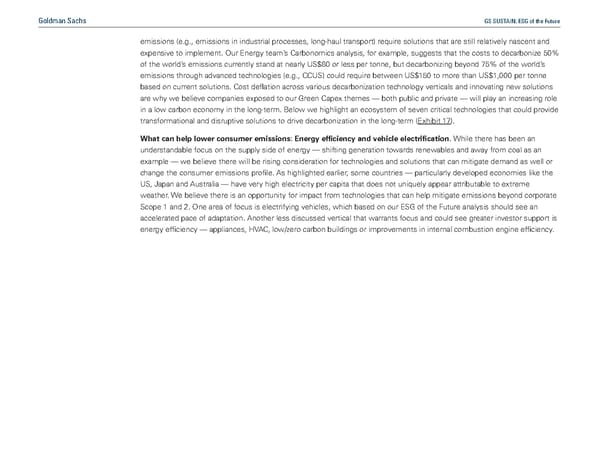Goldman Sachs GS SUSTAIN: ESG of the Future emissions (e.g., emissions in industrial processes, long-haul transport) require solutions that are still relatively nascent and expensive to implement. Our Energy teams Carbonomics analysis, for example, suggests that the costs to decarbonize 50% of the worlds emissions currently stand at nearly US$80 or less per tonne, but decarbonizing beyond 75% of the worlds emissions through advanced technologies (e.g., CCUS) could require between US$150 to more than US$1,000 per tonne based on current solutions. Cost deflation across various decarbonization technology verticals and innovating new solutions are why we believe companies exposed to our Green Capex themes — both public and private — will play an increasing role in a low carbon economy in the long-term. Below we highlight an ecosystem of seven critical technologies that could provide transformational and disruptive solutions to drive decarbonization in the long-term (Exhibit 17). What can help lower consumer emissions: Energy efficiency and vehicle electrification. While there has been an understandable focus on the supply side of energy — shifting generation towards renewables and away from coal as an example — we believe there will be rising consideration for technologies and solutions that can mitigate demand as well or change the consumer emissions profile. As highlighted earlier, some countries — particularly developed economies like the US, Japan and Australia — have very high electricity per capita that does not uniquely appear attributable to extreme weather. We believe there is an opportunity for impact from technologies that can help mitigate emissions beyond corporate Scope 1 and 2. One area of focus is electrifying vehicles, which based on our ESG of the Future analysis should see an accelerated pace of adaptation. Another less discussed vertical that warrants focus and could see greater investor support is energy efficiency — appliances, HVAC, low/zero carbon buildings or improvements in internal combustion engine efficiency.
 GS SUSTAIN: ESG of the Future Page 23 Page 25
GS SUSTAIN: ESG of the Future Page 23 Page 25